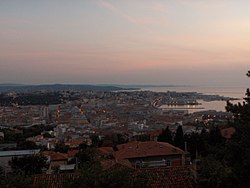Trieste
Trieste (Latin Tergeste, Italian Trieste,German and Friulian Triest, Slovenian and Croatian Trst) is a city in northeastern Italy, capital of Friuli-Venezia Giulia region and Trieste province, with a population of 211,184 (2001). It is located 600 kilometers south-southwest of Vienna at the head of the Gulf of Trieste, an arm of the Gulf of Venice.
Overview
The sights in Trieste include Miramare, a romantic castle built in the 19th century for Austrian Archduke Maximilian and his wife. On the coastal road to Trieste is the Abdus Salam International Centre for Theoretical Physics, operating under the aegis of UNESCO and IAEA.
Through a long period of time, Trieste was seen as being peripheral to the centers of Italian commerce and culture, and lost influence—however lately it has been gaining influence as Italy's window to the east.
The local Venetian dialect of Trieste is called "Triestino" in Italian and "Triestin" (pronounced /tri.e.stin/) in the local language itself. Italian and the local venetian dialect are spoken in the city center while Slovenian is partially spoken in many of the immediate suburbs. Italian-speaking and Slavic-speaking locals are considered autochthonous into the border region of Trieste, eastern Friuli and Istria. A fair number of German-speakers are native to the city too.
History
By 177 BC, Trieste was under the governance of the Roman republic. Trieste was granted the status of a colony under Julius Caesar. It was also he that recorded its name as Tergeste in his Comentarii de bello Gallico in 51 BC.
After the end of the Western Roman Empire (in 476) Trieste was first under the authority of their count-bishop, then (from the year 1081) loosely under the Aquileia's patriarchy, then (from the year 1369) under the Venetian Republic, then (from the year 1372) a free commune and then, (from the year 1382) to free themselves from Venice, the Triestins donated the city to Leopold III von Habsburg, duke of Austria. (See the original Latin version of the Dedication)
During the Middle Ages, Trieste grew into an important port and trade hub. It was constituted a free port by Emperor Charles VI and remained a free port from 1719 till July 1 1891. Its role as the principal Austrian commercial port and shipbuilding center was emphasized by the construction of the Vienna-Trieste railway, completed in 1857.
In the beginning of the 20th century, Trieste was a buzzing cosmopolitan city frequented by artists such as James Joyce, Italo Svevo and Umberto Saba. The city was a very real part of Mitteleuropa, with a cosmopolitan mix of Italian (52%), Germanic (6%), and Slavic (31%) elements (along with others), as well as a border-town feeling that it retains even today.
The thought of an Italian population under Austrian domination was offensive for many Italian nationalists, who considered Trieste Italy's main "unredeemed" territory; whence the term "irredentism" for the movement pleading for incorporation to the Italian state of every Italian population. After World War One ended Trieste was transferred to Italy.
On May 1 1945 the Yugoslav army entered Trieste one day before before the New Zealand army, in a race to decide who would control the city. The German Army surrendered to New Zealand army on May 2, which then forced the Yugoslavs to leave. The Yugoslavs capitulated on May 12 and left on June 12. [1] [2]
In 1947 Trieste became the capital of the Free Territory of Trieste. When that state was de facto dissolved in 1954, the city of Trieste reverted back to Italy, while the southern part of the territory went to Yugoslavia.
Literature
Many famous writers lived and created their major works in Trieste.
Italian writers:
- Italo Svevo
- Umberto Saba
- Scipio Slataper
- Enzo Bettizza
- Fulvio Tomizza
- Claudio Magris
- Pino Roveredo
- Susanna Tamaro
Slovenian writers:
Other writers:
Other famous people
- Vittorio Vidali (aka Enea Sormenti, Jacobo Hurwitz Zender, Casrlos Contreras), assassin.
See also
- International School for Advanced Studies, located in Trieste.
- University of Trieste, located in Trieste.
- International Centre for Genetic Engineering and Biotechnology, located in Trieste.
- National Institute of Nuclear Physics, located in Trieste.
- Trieste Astronomical Observatory, located in Trieste.
- Central European Initiative, located in Trieste.
External links
- Municipality of Trieste(in Italian)
- Welcome to Trieste
- Guide to Trieste and its Riviera
- Trieste in Pictures CD-ROM
- Trieste No-Borders Airport - Ronchi dei Legionari
- Trieste Tourism
- Chamber of Commerce, Industry, Crafts and Agricolture of Trieste
- ItalianVisits.com
| L'Aquila (Abruzzo) · Aosta (Aosta Valley) · Bari(Apulia) · Potenza (Basilicata) · Catanzaro (Calabria) · Naples (Campania) · Bologna (Emilia-Romagna) Trieste (Friuli-Venezia Giulia) · Rome (Lazio) · Genoa (Liguria) · Milan (Lombardy) · Ancona (Marche) · Campobasso (Molise) · Turin (Piedmont) |
| Regions of Italy | ||||
|---|---|---|---|---|
| Abruzzo • Aosta Valley • Apulia • Basilicata • Calabria • Campania • Emilia-Romagna • Friuli-Venezia Giulia • Lazio • Liguria • Lombardy • Marche • Molise • Piedmont • Sardinia • Sicily • Trentino-South Tyrol • Tuscany • Umbria • Veneto | ||||

